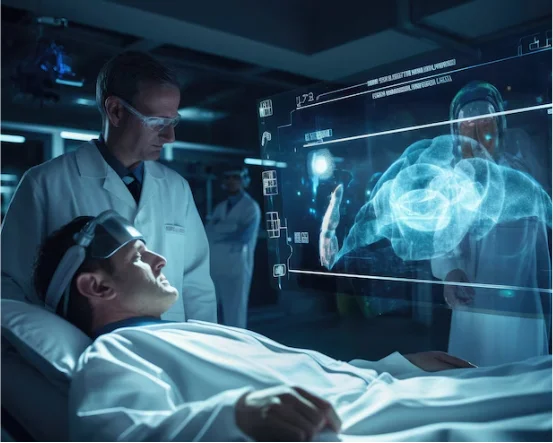Neuroendoscopy is a new minimally invasive surgical procedure utilized to treat various brain diseases. This procedure involves insertion of a small endoscope, equipped with a camera as well as surgical tools through small holes in the spinal cord or skull to gain access to the deeper regions in the brain. Neuroendoscopy is a preferred alternative to conventional open surgery for surgical procedures for the brain in a variety of instances because of its precision, speed of recovery, and lower risk of complications. Understanding the causes for neuroendoscopy surgery is essential for patients seeking treatment options.
Since its inception the development of neuroendoscopy has transformed the way that neurosurgical procedures are used to treat disorders like hydrocephalus, brain tumors, and cysts. But what is the reason that leads a neurosurgeon or surgeon to suggest this procedure?
Why is Neuroendoscopy Surgery Performed?
1. To Treat Hydrocephalus (Build-up of Brain Fluid)
One of the main reasons for undergoing neuroendoscopy is treatment of hydrocephalus, which is a condition that is characterized by the accumulation of cerebrospinal fluid (CSF) within the ventricles of the brain. This can result in an increase in pressure within the skull, leading to nausea, headaches and vomiting, balance issues and cognitive issues.
Neuroendoscopic procedures such as the Endoscopic Third Ventriculostomy (ETV) can be carried out to open a path for CSF flowing freely and alleviating pressure without having to use implanted shunts. This technique is especially helpful for patients suffering from obstructive hydrocephalus. the blockage hinders normal drainage of fluid.
By recognizing the causes for neuroendoscopy surgery, both patients and medical professionals can better navigate the treatment landscape and make informed decisions regarding care.
2. Brain Tumors and Cystic Lesions
Neuroendoscopy plays an important role to remove brain tumors particularly those that are situated near the ventricles or at the nerve base. Colloid lumps, pituitary tumors pineal region tumors, as well as ventricular tumors are usually treated by endoscopic methods.
The endoscope is able to:
- Biopsy and Tumor Visualization
- Resections of all or part of it
- Reduced damage to the surrounding brain tissue
This procedure reduces the risk of trauma and provides a quicker recovery post-operatively compared to conventional craniotomies.
3. To Perform Biopsies in Deep Brain Structures
In a variety of neurological conditions, a biopsy of the brain is necessary to identify the root cause. If there is a tumor or an abnormal tissue is found in a sensitive or deep region, conventional biopsy techniques could be dangerous.
Neuroendoscopy offers a more secure more precise, focused, and specific method to collect tissues from:
- Pineal region
- Third ventricle
- Space Intraventricular
This method reduces the need for big skull openings, and reduces the risk of trauma to brain tissue.
4. Treatment of Arachnoid Cysts
Arachnoid cysts are a collection of fluid-filled sacs situated between the brain, or spinal cord as well as the membrane arachnoid. The cysts may cause a symptom when they grow larger or press against the brain’s structures.
Endoscopic fenestration is a commonly used neuroendoscopic procedure. It involves creating openings within the cyst wall that allow for the flow of fluids into the brain’s natural channels by releasing pressure and reducing symptoms like:
- Headaches
- Seizures
- Developmental delays in children
5. Intracranial Hemorrhage or Ventricular Clot Removal
The bleeding into the brain’s ventricular system require neuroendoscopic intervention to eliminate blood clots that block CSF flow. The removal of these clots will prevent hydrocephalus, as well as other problems related to an increase in intracranial pressure.
The low-invasive process is perfect in emergency situations and for patients who are fragile, particularly those with a newborn or elderly condition.
6. Pituitary Tumors and Skull Base Lesions
Neuroendoscopy and especially endoscopic surgery, permits access to pituitary adenomas as well as various skull-based tumors via the sinus cavity and nose. This procedure does not require surgical incisions on the outside and decreases the chance of brain injury.
This kind of neuroendoscopic surgery can be used to:
- Excess pituitary tumors in the pituitary
- Drain cysts
- Eliminate abscesses or infections near the brain’s base.
Benefits of Neuroendoscopy Surgery
Alongside addressing severe medical conditions Neuroendoscopy also has a variety of distinct advantages:
- Minimally Invasive: Tinier incisions means lower risk of trauma to brain tissue and the surrounding tissue.
- Speedier Recovery: Patients typically get faster post-operative recovery, and shorter hospital stay.
- Reduced Risk of Infection The smaller openings lower the risk of infection as well as leaked cerebrospinal fluid.
- Improved Visualization: High-definition Endoscopes allow neurosurgeons access to areas that are hard to access using traditional methods.
- Less complications: Lower brain exposure and blood loss will result in fewer complications and improved overall outcomes.
Who Needs Neuroendoscopy Surgery?
Neuroendoscopy is generally advised for:
- Pediatric patients suffering from congenital hydrocephalus
- Adults who have ventricular tumors or cysts
- Patients needing diagnostic brain biopsies
- People who suffer from pituitary gland issues
- In emergency cases, bleeding or blockages of the flow of fluid in the brain
An exhaustive neurological evaluation and the brain scan (MRI or CT scan) as well as an evaluation by an expert in neurosurgery are crucial before deciding whether neuroendoscopy is the best option.
Conclusion
Understanding the reasons behind neuroendoscopy is crucial to understanding the importance of this procedure that is minimally invasive in the field of modern neurosurgery. If it’s dealing with the effects of hydrocephalus, eliminating brain tumors or draining cysts, the neuroendoscopy procedure is an effective, safe and comfortable alternative to traditional open surgery for brain.
If you or someone close to you has neurological signs, like frequent headaches, eye issues, or other coordination issues, speaking with an expert neurosurgeon or neurologist will aid in early diagnosis and treatment plan. As the field of neuroendoscopic surgery has advanced, techniques, a variety of previously difficult neurological conditions are now being managed more efficiently and with less risk of surgery.























